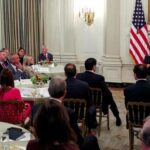Navigating Tariffs on Smartphones and Technology: What You Must Know
Tháng 4 13, 2025
Maine’s Child Nutrition Programs: Unpacking Federal Funding Disputes and Transgender Rights
Tháng 4 13, 2025Understanding the Recent Developments in Tariffs on Electronics
The landscape of global trade has been significantly influenced by tariffs imposed on various electronics, including smartphones, computers, and semiconductor chips. As businesses navigate this complex environment, keen awareness of these developments is essential for consumers and manufacturers alike.
Tariff Impacts on Electronics
Recent applications of tariffs on imported electronics represent a critical concern for technology manufacturers around the globe. These tariffs, often initiated in response to international trade conflicts, can inflate costs across the supply chain. This inflation ultimately trickles down to consumers, leading to increased prices for everyday electronics such as smartphones and laptops. When tariffs are levied at rates as high as 20%, the burden felt by both consumers and producers intensifies, creating a ripple effect that impacts purchasing behavior and demand within the market.
Furthermore, these tariffs may necessitate alterations in long-standing supply chain relationships. Companies may find themselves reassessing their operational strategies, as the need to manage costs becomes paramount. The decisions made in response to these tariffs could stymie innovation as resources are redirected toward compliance and strategic adjustments instead of development. For instance, in light of the ongoing discussions around tariffs, China’s President Xi Jinping has recently met with global CEOs to address U.S.-China trade tensions, emphasizing the importance of international stability and collaboration, which can further affect the tech industry. Read more about Xi’s strategic moves here.
Trade Agreements and Negotiations
In light of these tariff challenges, governments across the globe frequently engage in negotiations to reformulate trade agreements. The objective of these dialogues is to reduce or eliminate tariffs on specific goods, thereby facilitating smoother trade flows between nations. Such agreements can lead to considerable economic benefits, promoting stability and growth within industries reliant on international trade.
However, the complexity of global trade negotiations underscores the uncertainty businesses face as they respond to fluctuating tariffs. The outcome is influenced by various factors, including diplomatic relations and economic considerations, making it essential for manufacturers to stay informed about evolving trade policies.
Economic Implications
The existence of high tariffs can engender broad economic ramifications. For consumers, this translates to higher prices and potentially less choice as market dynamics shift. The competitive landscape of the tech industry can also undergo substantial changes, as some companies may struggle to maintain profitability in a landscape characterized by increased costs. In turn, this could prompt businesses to relocate manufacturing operations to countries where trade conditions are more favorable, further altering global market dynamics.
Recent News and Updates
Recent reports highlight that certain electronics will continue to be subjected to tariffs, emphasizing the importance of keeping up with official announcements and industry reactions. Significant players in the tech sector, such as Apple, Samsung, and Intel, may publicly articulate their responses to these tariffs, adjusting their strategies to mitigate negative impacts.
Moreover, economic analysts and journalists have begun to analyze the potential outcomes stemming from the continued imposition of tariffs. Discussions focus on price adjustments, shifts in supply chain practices, and the overall health of the industry. With the evolving nature of global trade, these discussions remain pertinent as businesses and consumers navigate the present landscape.
To remain updated on these developments, it is advisable to follow reputable news sources such as Bloomberg and CNBC, as well as government press releases. By staying informed, stakeholders can better adapt to the ongoing changes in the technology trade environment, fostering an understanding that is crucial in today’s highly interconnected world.
